By Alison Butlin, Chris Hopkins, Mary Grover and Val Hewson
Impressions of Latterday Symphony (1927) by Romer Wilson
Recently our group read books by novelist, poet, short story writer and anthologist Romer Wilson (1891-1930), whose work has been almost entirely forgotten. We usually read popular fiction, which was never Wilson’s focus, but she was born and grew up in Sheffield and so interests us.
Here, from three of our group, Alison Butlin, Chris Hopkins and Mary Grover, are impressions of Latterday Symphony, and a summary by another member, Val Hewson, of contemporary reviews. It is a novel which attracts strong opinions, both favourable and unfavourable, as much now as when it was published in 1927.
First Impressions (and Subsequent Discussions) (Alison Butlin)
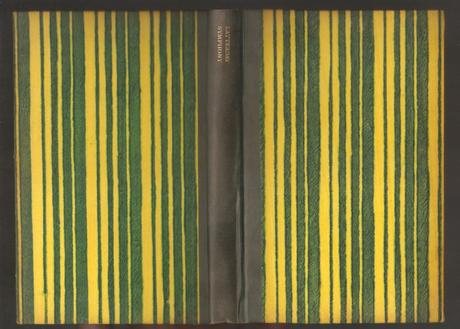 The Cover of Latterday Symphony
The Cover of Latterday Symphony
My first impressions of this novel were, unfortunately, disappointing because the book that I bought is horrible, printed on poor quality paper, and very roughly cut, with, in my view, a dowdy and unattractive cover. I understand now that this was considered to be a stylish and ‘up-market’ product in the 1920s, which just shows how tastes change as it certainly does not appeal to my 21st century sensibilities!
It is one of three books by Romer Wilson published in 1927. It focuses on a very small number of characters who attend three parties over the course of twenty-four hours. They are almost exclusively very wealthy people leading decadent and hedonistic lifestyles. The main character, Stephen Russell, is a man who has recently returned from Spain where he had gone to escape an unsuccessful love affair. The object of his desire appears at the party and the remainder of the book is about his efforts to re-engage with her.
Romer Wilson portrays a black character in the book, who is openly and repeatedly insulted within the narrative, at least by most but perhaps not all characters within it. Stephen acknowledges as does Lindsay himself that, if it was not for the color of his skin, Lindsay Jackson would be a stronger competitor for the woman, Mary Linton, whom he wants:
Stephen looked at Lindsay Jackson. He saw nothing whatever in him but the light coffee shade of his complexion that would make him come amiss with Mary Linton. In open class Stephen knew that he himself fell a long way short of Jackson’s standard, alike as an Adonis, an artist, and a gentleman (Latterday Symphony, Nonesuch Press, London, 1927, p.33)
Is the author trying to point out the unacceptability of this kind of racism in society, or simply using Jackson to add some variety to the characters?
On further reflection, I would concur with Chris Hopkins and Mary Grover (see below) that Lindsay Jackson and his developing relationship with Stephen Russell are central to the book, and that there is a clear anti-racist theme.
There are some examples of stylistic variations within the text. For example, right at the beginning (pp. 1-2), Wilson repeats the words ‘syncopate’ and ‘sensuous’ to create the atmosphere at the party where jazz is the background to interactions between self-conscious individuals who clearly see themselves as a superior ‘smart set’. I think she does achieve this portrayal successfully, and I am repelled by these characters. But perhaps that is her intention? Later, the author attempts to convey the debauched nature of the second party through the drunken voice of its host, which I just found difficult to make sense of, and slightly irritating. Once again, though, is that the author’s intention?
My view now is that the author did intend to demonstrate the emptiness and futility of the lives being led by the characters who moved in the social circle she describes. The fact that Wilson came from a wealthy family and was an undergraduate in Cambridge suggests that she would have been familiar with this sector of society.
I gather that Romer Wilson had a reputation for exploring philosophical issues through her writing, so I asked my son Patrick, a philosopher, to read the book and share his perspective. He wrote:
I think the book includes various themes or features that could be interpreted as existentialist, but I’m ultimately not convinced of that interpretation. I have in mind: the waiting and boredom; the observations about purposelessness, and more generally Stephen’s introspection and his distressed state; mention of the absurd; and some of the ways in which the characters talk about God. The reason I’m not convinced is that I think Stephen’s emotions fit a familiar literary pattern for descriptions of the distress that love can cause. It’s not clear that he’s distressed by the purposelessness of life in general, or life in a godless world, say – instead he feels that life is purposeless without Mary. If we interpret all the anguish as a standard romantic trope, I don’t think there’s enough evidence left to interpret the book as philosophical. That’s the case especially because there’s nothing obviously philosophical about the scenario or the plot.
A further reason to think this is that 1927 is before existentialism was recognised as a philosophical movement, which came with Sartre, Camus, de Beauvoir and others in the 1940s and 50s. 1927 is actually the year of publication of Heidegger’s Being and Time, one of the most important precursors of, and influences on, the existentialists. Nietzsche and Kierkegaard (in philosophy) and Dostoyevsky (in literature) had written about proto-existentialist ideas in the nineteenth century, but I don’t think there’s much evidence of their influence in the book.
We also talked about the film watched by Russell and Jackson whilst they await the afternoon tea party where they hope to meet Mary Linton again. Sky House is described in some detail at this point in the book, and is referred to again and praised by the attendants at the tea party. Patrick commented that:
What happens in the film is not essential to the plot, or to the other main themes of the book, so the fact that it’s described in detail, and that it’s about the construction of a skyscraper, is an interesting choice which demands explanation. 1927 was the year of Metropolis, and a film called Skyscraper came out in 1928, but I haven’t been able to find one which was a particularly likely inspiration. I do think, though, that skyscrapers were particularly exciting and potent symbols of modernity in the 1920s. I’m not sure why Wilson includes this, though – e.g. whether she is being critical of modernity at this point in the book. It’s perhaps notable that the film is not only about a skyscraper, but also about a worker on the skyscraper and his literal and metaphorical elevation about the other people in the city. That could be seen as a bit Nietzschean.
I noted that criticism of new building in London is voiced by Jackson as they leave the cinema.
‘I don’t like your new style of street somehow,’ he said vaguely. ‘It doesn’t perfectly remind me of little ole London, nor the Champs-Élysée [sic], which it kind of looks to be trying for.’
‘It’s been built in a bad temper,’ sighed Stephen. ‘It means about as little as the rest of this decade. …’ (Latterday Symphony, p.83).
So, perhaps this indicates that there is an element of criticism of modernity within the book, and maybe the film is integral to that theme.
Overall, I found the book puzzling, I struggle to understand what Romer Wilson was trying to achieve. I still fundamentally find Latterday Symphony a pretentious and unsatisfactory read. For me, if an author is going to use the novel form to explore broader themes, the story itself needs also to be satisfying in some way, and even on a second reading, I did not enjoy Latterday Symphony as a novel.
Second Impression (Chris Hopkins)
I bought the same edition, which as far as I can see was indeed the only edition ever published, and the physical design of the book did make something of an impression on me. In many ways I shared all of Alison’s immediate responses to the physical features of the book, as well as its contents, and I think she raises lots of productive questions. The book cover has an abstract design of alternating yellow and green stripes organised into groups of four which look at first irregularly spaced. Though it is actually a regular pattern of four groups, it does not immediately appear as one, perhaps giving a sense of a hand-made product. This may be reinforced by the green stripes having a printed texture which looks like wool, giving the illusion of its fibres protruding slightly from the flat surface of the cover, in contrast to the smooth-textured yellow strips. However, I did vaguely recall that the publishers, the Nonesuch Press, produced not cheap, mass-production books, but on the contrary published small editions of collectable or ‘fine art books’.
Some digital searching has now confirmed this memory. I also had a feeling that the rough-cut pages (which do lack neatness and which I do not like therefore!) were also not necessarily a sign of cheap production methods but oddly enough signalled a superior and more expensive kind of book (I should point out that I am by training more a literary critic than a book historian, so that this kind of knowledge is at the edges of my expertise).
 The ‘Deckle-edged’ pages of Latterday Symphony
The ‘Deckle-edged’ pages of Latterday Symphony
Actually, online searches for ‘rough-cut pages’ produced only a few useful results, but these included an alternative term for the same effect which proved more useful. These ‘rough-cut pages’ were (and are) also called ‘deckle-edged pages’. A ‘deckle’ was originally a wooden tray for producing individual pages of hand-made paper, which inevitably emerged when the ‘paper pulp slurry’ was set with uneven or ‘deckle-edged’ pages. A Wikipedia article on the ‘deckle’ was very helpful in enabling me to understand the hand paper-making process and also the history and cultural meanings associated with deckle-edged paper. I think the following quotation helps explain not only the production processes involved, but also some of our initial response:
Before the 19th century the deckle edge was unavoidable, a natural artifact of the papermaking process in which sheets of paper were made individually on a deckle. The deckle could not make a perfect seal against the screen at the edges and the paper slurry would seep under, creating a rough edge to the paper. Beginning in the 1800s with the Foudrinier Machine, paper was produced in long rolls, and the deckle-edge became mostly obsolete….
With the appearance of smooth edges in the 19th century, the deckle-edge slowly emerged as a status symbol. Many 19th century presses advertised two versions of the same book: one with edges trimmed smooth, the other a higher-priced deckle version. This suggested the deckle book was made with higher quality paper, or with more expensive methods. This tradition carried forward into the 20th and 21st centuries [though now a machine cuts originally smooth edges into deckles after their initial production …]. Ironically the apparent value of a deckle-edge is, in part, the impression that it is hand-made, an inherently greater expense than mass-production.
Many modern readers are unfamiliar with the deckle edge and may see it as a defect; for example, Amazon.com has left notes to book-buyers clarifying that the deckle edge is not a flaw in the product [there is a reference to an article in the Economist, ‘Deckle Detecting’, 15/7/2012].
Clearly, responses to deckle-edged books are part of a rather complex code of value in which appearance and actual production processes are not aligned as one might expect!
I also noted that the novel does not seem to have been sold with a separate paper dust-wrapper, which was unusual at this time, but also seems to have been the case for a number of other Nonesuch books. Instead, the paper-cover with its original design is glued directly to the black hard-binding. Overall, I get the impression that the external features of this book are displaying a degree of unconventionality, originality, and a one-off design intended to match a specific text. Indeed, this fits with the general ethos and production values of the Nonesuch Press. In his memoir, the founder of the Nonesuch Press, Francis Meynell, outlined his intentions:
So I myself set out to be a new kind of publisher-designer, an architect rather than builder … we were lucky in our hour: we were the first to cater for a large, growing and unsatisfied interest in ‘fine books’ at less than the fine prices required by the great ‘private presses’. (My Lives, Bodley Head, London, 1971, p.155, quoted in Ashley Montagu’s article ‘The Nonesuch Press’, The Princeton University Library Chronicle, Winter 1983, Vol. 44, No. 2, pp.127-134, p.130).
Ashley Montagu observes that:
Meynell’s purpose was to fit the book appropriately to the text, ‘allusive or sensitive design’ as he called it. This required attention to every detail of the book (Ashley Montagu, ‘The Nonesuch Press’, p.133).
Indeed, in a review of Nonesuch Press’s own book about the history of the Nonesuch Press, Latterday Symphony is picked out for particular praise:
‘Perhaps the volume that, aesthetically at least, would best repay imitation is a short five-shilling novel, “Latterday Symphony”, by Romer Wilson’ (unsigned review in the Times Literary Supplement February 22, 1936, p.156 of The Nonesuch Century by Frances Meynell, A.J.A Symons and Desmond Flower, the Nonesuch Press).
I suppose that in the case of Latterday Symphony, the quite complex patterning of the cover might be a rhythmic visual equivalent to the invocations of musical form and rhythm within the text (I am tempted to say that the broadest green band in the design could be read as a form of syncopation – an unusual musical/visual stress, but perhaps that would be to over-interpret). There are also eight other visual features not yet mentioned which are inside the covers, including two striking title pages, the dedication, the contents list, and the four chapter-headings, three of which at least are variations on a theme which has its first exposition in the second title page (the four chapters probably also echoing the typical four-movement form of the classical symphony):
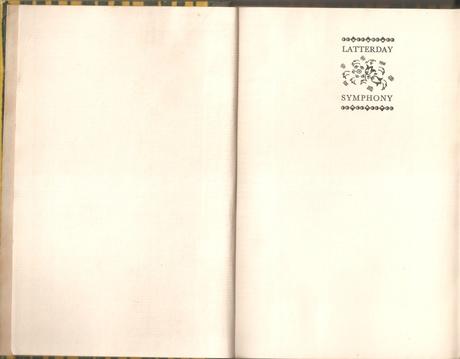
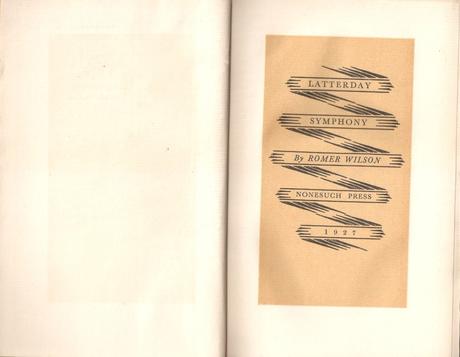 Title Page and Frontispiece
Title Page and Frontispiece
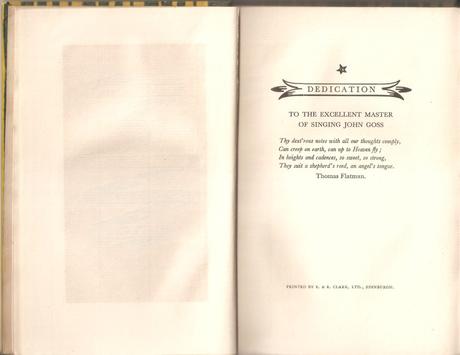
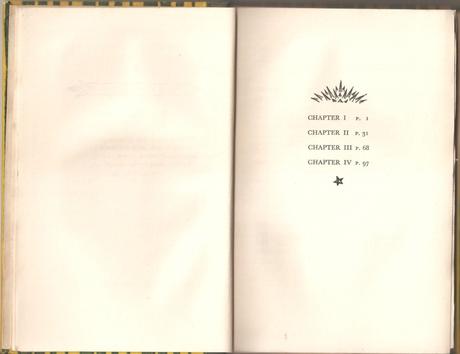 Dedication and Chapter List
Dedication and Chapter List
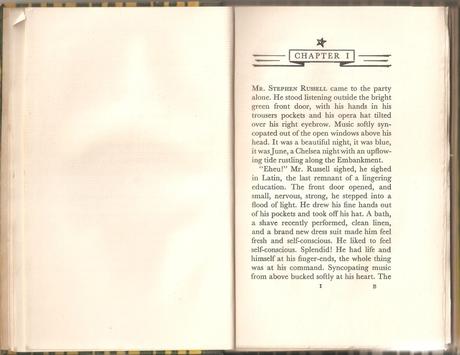
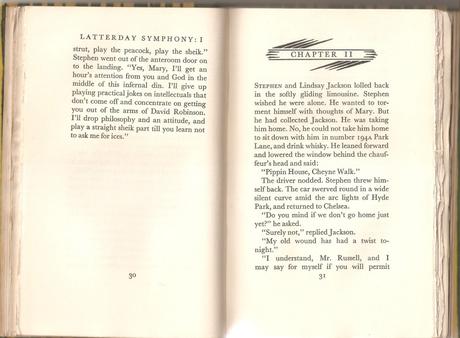 Chapter 1 and Chapter 2 Headings
Chapter 1 and Chapter 2 Headings
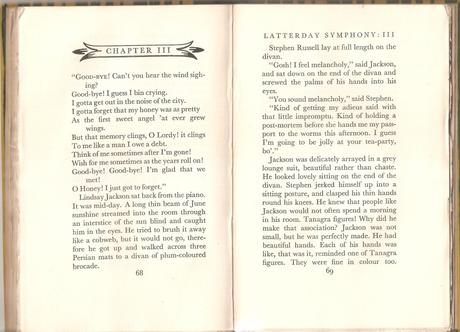
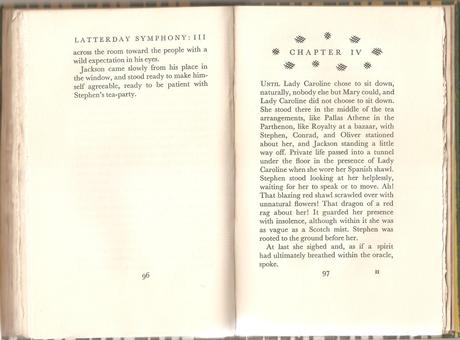 Chapter 3 and Chapter 4 Headings
Chapter 3 and Chapter 4 Headings
These all seem good examples of Meynell’s wish to use ‘allusive or sensitive design’, where the book design becomes part of the meaning and effect of the verbal text. This external originality and avant-gardism also match the style of the novel, which, within a couple of pages, I felt was somewhat like a modernist stream of consciousness:
Mr Stephen Russell came to the party alone. He stood listening outside the green front door, with his hands in his trousers pockets and his opera hat tilted over his right eyebrow. Music softly syncopated out of the open windows above his head. It was a beautiful night, it was blue, it was June, a Chelsea night with an upflowing tide rustling along the Embankment (Latterday Symphony, p.1).
This could be read as an external description or narration, but it seems more like an internal rendering of how Stephen experiences this moment. It is perhaps his perceptions which give the jazz an agency and independent life of its own, with a suggestion that it has escaped from human control: ‘music syncopated out of the open windows’. The phrase ‘it was blue’ could be a literal description of the night, but it seems also to suggest a world of artistic impressions and colour-values – and indeed I wonder if a specific painting is invoked – Whistler’s Nocturne: Blue and Silver – Chelsea (1871), which would certainly give Stephen’s thoughts a clear impressionist genealogy.
Nocturne: Blue and Silver – Chelsea 1871 James Abbott McNeill Whistler 1834-1903 Bequeathed by Miss Rachel and Miss Jean Alexander 1972 http://www.tate.org.uk/art/work/T01571; ‘Nocturne: Blue and Silver – Chelsea’, James Abbott McNeill Whistler, 1871 | Tate, available under a Creative Commons license.Whistler’s own synaesthetic ideas of painting and music seem very like some of the musical-verbal ideas which this novel goes on to develop. Whistler explained:
By using the word ‘Nocturne’ I wished to indicate an artistic interest alone, divesting the picture of any outside anecdotal interest which might have been otherwise attached to it. A nocturne is an arrangement of line, form and color first (the quotation is taken from the Tate’s very helpful ‘summary’ of the painting – see ‘Nocturne: Blue and Silver – Chelsea’, James Abbott McNeill Whistler, 1871 | Tate).
Latterday Symphony does not itself at all dispense with narrative interest, but Stephen is shown often as having an urge to experience only pure form rather than taking part in society and conventional human narratives, though this is clearly partly a response to the pain of his rejection by Mary Linton. Even on the first page we see him trying to live solely in an inner world of artistic impressions:
He liked to feel self-conscious. Splendid! He had life and himself at his finger-ends, the whole thing was at his command. Syncopating music from above bucked softly at his heart. The night was entirely sensuous, delicately sensuous. He loved it. (Latterday Symphony, pp.1-2).
However, the urge to be in command of the experience seems an opposing impulse to the impulse to lose himself in form, perhaps signalling a degree of inauthenticity in his withdrawal from mundane life.
I also had, like Mary Grover (see below), quite a strong feeling from early on that the style and content was influenced by a specific and noted modernist novel, Virginia Woolf’s Mrs Dalloway, published two years earlier in 1925, by the Hogarth Press. (Woolf and Wilson moved in the same circles[i].) This modernist approach may help address some of Alison’s questions about what we are to think about the characters and especially about the racist treatment of Lindsay Jackson. Like Mrs Dalloway, Latterday Symphony avoids any explicit guidance from an authorial narrator, leaving judgements about Clarissa Dalloway or Peter Walsh or Lindsay Jackson or Stephen Russell to the liberated (and/or puzzled!) reader. The Hogarth Press was itself founded by Virginia and Leonard Woolf in 1917 specifically to print avant-garde writing. At first, the Woolfs hand-printed all their books, but then used commercial printers to carry out their intentions making it a more viable but not wholly ‘commercial’ press, a similar practice to that of the Nonesuch Press. Mary makes further points about similarities between Latterday Symphony and Mrs Dalloway below. I did note though that whereas Mrs Dalloway has interior as well as notable exterior scenes in London streets in which characters render their environments through their streams of consciousness, Latterday Symphony is almost wholly set in interiors, which gives it a certain claustrophobia and reinforces a sense of the characters being trapped in each other’s company, anticipating indeed a novel like Waugh’s Vile Bodies. A favorable early review of Latterday Symphony points out this concentration on interior settings: ‘Miss Romer Wilson stages a brief, fantastic tragedy in the setting of two evening parties, and an afternoon tea’ (Unsigned review on the ‘Current Literature Page’, The Scotsman, 26 May 1927, p.2). The final section of this article looks at the original reviews in detail but in brief, with the exception of some reviews which saw Latterday Symphony as realizing their worst fears about modern life and modern writing, most contemporary reviews were indeed favourable and impressed by the novel. The Scotsman review, for example, concluded:
It is a remarkable book, which paints a hectic side of life with a fluent, graceful touch. The characters are all cleverly drawn, particularly Jackson, an artist to his finger-tips, grave, chivalrous, and quaint at the same time, and bearing himself with a half-melancholy dignity in the isolation which he feels to be imposed upon him by his color.
This review concurs with Mary Grover’s view that really Lindsay Jackson is the most significant character in the novel, and even notes his internalization of racism, which I found the most disturbing aspect of the novel’s representations of race – I would so much have preferred Lindsay’s resistance to gross stereotypes – but this internalization might be seen as Wilson showing the depth of Lindsay’s oppression, in addition to his shamefully explicit racist treatment by the palpably gross ex-public schoolboy, Conrad Hallard – despite the latter’s claim to have ‘got over’ his racist education (Latterday Symphony, p.38).
Another substantial review by the then famous novelist and celebrity Beverley Nichols in his column ‘The Literary Lounger’ for the Sketch also praises the novel, links it to a characterization of Twenties modernity, and, if in the idiom of its time, sees it as a work opposing racism, and valuing jazz as much as ‘western’ music:
Top Speed
A very pretty theory might be worked out by the modern philosopher to indicate the relationship between the speed at which we live and the speed at which we love. Because we can fly to Gretna Green in six hours instead of six days, are we to suppose that the marital bliss which is to follow such an adventure would be correspondingly shortened? Because we go to four parties in a night, drink four times as many cocktails, and smoke four times as many cigarettes, listening to music which is madder than even the last generation could conceive, clipping our speech until it resembles a form of shorthand, are our emotions, in a corresponding ratio, cut up and concentrated, at once more intense and shorter lived? If the philosopher were to work out his theories from such a book as Latterday Symphony by Miss Romer Wilson, he might find ample evidence for this contention. This is one of the most truly modern books which I have ever read. It is more modern even than Manhattan Transfer [by the American modernist John Dos Passos, 1925], although it has none of the jagged technique or jerky rhythms of that remarkable work. It is modern not so much in technique as in spirit. The whole action takes place in a space of twenty-four hours, in which time we are taken to three parties one smart, one Bohemian, and one intimate. At those parties we witness the rise and fall of two men’s love for the same woman. It is a theme from which an old- fashioned novelist might well have fashioned three bulky volumes, yet Miss Romer Wilson, with the same sort of intensity as a topical film budget, which gives the events of the world in the space of three minutes, concentrates her story between the narrow limits of a night and a day. The tale has not only a very modern, but even a very topical interest, because, of the rival lovers, one is a negro who might well have stepped out of the company which is at present delighting the West End in Black-Birds. A few years ago nobody could have imagined it possible that London society would be fighting to obtain admission to parties which offered as their chief attraction a handful of talented coloured people. In the same way, a few years ago, nobody would have taken seriously the idea that a highly cultured, eminently desirable young woman would find it even remotely possible to marry one of a different color. It is significant, therefore, that, reading this book in February 1927, I had not the remotest sense of incongruity. It might well have been a tale told by somebody who had just come home from one of those hectic parties, somebody who was versed in the latest idioms, aware of the latest catchword, and profoundly steeped in the restless atmosphere of such gatherings. It is for this reason that I wonder if this story is merely a tour de force, a thing of the moment only, which will be forgotten as soon as the lights over the Pavilion flash out another sign and the last of the Black-Birds have flown across the Atlantic. I do not think that this is the case, however, for, though the violent modernity of the story is the first thing that strikes one, it has a deeper significance than that. These men are real lovers. Their woman is a real woman. The beauty which she inspires in them, and the agony which they endure at her departure, are real too. Even though steeped in the argot of 1927, there is an echo in their voices which rings back through the ages. It is, indeed, as though Miss Wilson had imagined some musical theme of genuine beauty, and had chosen to write it for a saxophone instead of a violin. Some people may be deceived into thinking that a saxophone cannot play true music. This book should convince them of their error (16 March 1927, p.44).
The West End show referred to by Nichols is Blackbirds of 1926, produced by Lew Leslie, in which a group of African-American musicians, including Florence Mills, were a big hit, with 276 performances at the London Pavilion (indeed some see exhaustion after this as contributing to the star’s sadly early death in the following year). As the title of the piece suggests, it is difficult to disentangle the impact of an African-American music and dance new to London from automatic racist assumptions. Though Romer Wilson is surely influenced by Mrs Dalloway, I think there are things of her own here too, the most notable of which is putting race at the center of this modernist novel. While the focus of the novel is purportedly Stephen Russell’s disappointed love for Mary Linton, which is then repeated in Lindsay Jackson’s equally disappointed love for her, the most moving, sensitive and intimate relationship actually seems to be that between Stephen Russell and Lindsay Jackson.
One final thought is about the film discussed by Alison, which Stephen and Lindsay go to see, and which the novel spends considerable effort on, though its place in the overall design of the novel does not seem immediately obvious. I wonder if it is in fact an important section of the novel, contrasting the film’s positive celebration of architectural modernism, and indeed the beneficial transformations offered by urban modernity with the two men’s experience of modern life as a futile loss of identity within their modern set. This would correspond to a frequent ambivalence in modernist writing in its attitude to modernity: while modernism often lauded modernity (look at the fascination of Mrs Dalloway – character and novel – with cars, aeroplanes, and London as metropolis), it also often saw modernity as leading to a loss of certainty and individual identity (indeed, that is there in Mrs Dalloway too). Though I completely take the point raised in Alison’s discussion with her professional philosopher son that this is not an explicitly or systematically philosophical novel, I think the self-doubts of Stephen and Lindsay about their own identities and authenticity can be linked to this modernist ambivalence to the modern. Strands of modernism wanted to overthrow the (allegedly) irrelevant and superseded grand narratives of the past (including, for example, theocentric accounts of the meaning of human existence), and while that could lead to a sense of liberation, it could also lead to disorientation and a loss of faith in the meaningfulness of human life lacking any grand narratives. The title of the novel itself, and the song which Lindsay sings early on, indeed evoke two different narratives of temporality: one about Judgement Day and the confirmation of the absolute shape of the grand narrative of Christianity, the other about a kind of modernity which is a contextless ‘nowness’ with neither shape nor potential for development. With the marked exception of the film as a text within the text, this novel emphasises a profoundly negative experience of the modern by its two central characters.
Third Impression (Mary Grover)
It may seem rather mean to put Romer Wilson’s Latterday Symphony alongside Virginia Woolf’s novel, Mrs Dalloway, but it is difficult to resist.
Wilson’s meditation on the allure of an attractive and unassuming young woman desired by every male member of the Bohemian set who encircle her is written in 1927, two years after Woolf’s evocation of the desirability of a politician’s wife to a man who has no hope of permanently attaching her. The focus of each novel is a forthcoming party when the beloved will be found by a hopeless lover. Both novels aim for a rough observation of the unities. The cast of central characters is fairly small and the length of each novel is short. The central observer in both novels is a man who seems fated to remain alienated from the society in which he moves and unattached to the woman he loves. Both novels end with a kind of epiphany: Woolf’s with the ‘terror’ and ‘ecstasy’ of the entrance of the woman long-loved at a large and splendid social gathering and Wilson’s with a final embrace from the adored ‘primitive child’ at a small social gathering set up to engineer this encounter. Wilson’s novel is a mixture of styles but most could be described as modernist in the manner of Woolf’s Mrs Dalloway which had been published two years earlier, in 1925.
Latterday Symphony seems to be a slavish pastiche or perhaps a homage to the recent work of a prestigious author. Sadly, the book is shown up by its model in too many ways to describe. But in one respect Romer Wilson’s novel is utterly remarkable and the subject matter unlike that of any modernist novel I have read. The compelling and central figure in the novel is not the desperate and world-weary lover Stephen Jackson whose devotion is rejected or the apparently unexceptional woman he pursues. The moral center of the bookis Stephen’s companion in his amorous quest, the black singer whose voice we hear on the first pages of the book.
Lindsay Jackson is a jazz singer. The fact that he is a superb musician sets him apart immediately from the rest of the novel’s characters who do not seem to be good at anything much. Whenever he sings, he stills the aggressive and racist chatter that surrounds him, creating a temporary respite from a world which is depicted as fragmented and inhumane. Jackson’s singing of the ‘syncopated’ melody identified as the ‘Latterday Symphony’ of the book’s title works far more consistently and powerfully on Stephen, and perhaps, the reader, than any epiphany connected with the woman he loves. In fact, Mary becomes, during the course of the book, interesting only in the respect that the she is an object of desire of a man who cannot court her because of the color of his skin. He cannot even experience rejection because to declare his love would be socially unthinkable. As he puts it. ‘Love is sure a melancholy extravagance for a coloured man.’ (Latterday Symphony, p.25).
The only attractive feature of Stephen is that from the outset of the novel he identifies the monstrosity of this situation. As he stands outside the door listening to the music and half-heartedly wondering whether or not to kiss the maid, he declines to be introduced to the gathering. Instead of kissing the maid he tries to educate her. He delays entering the room in order to counter her racism. He explains that the ‘two black gentlemen’ she has blushingly dismissed have names and are the celebrated duo, Beverley and Jackson: ‘Coloured gentlemen, not black gentlemen, in case you are asked by any other fool to-night. Rest assured about the “gentlemen”.’ (Latterday Symphony, p.3) His attempt to assert the musicians’ dignity may be clumsy and the vocabulary dated (‘coloured’ was clearly perceived as less racist than ‘black’ in 1920s London), but Wilson is trying to demonstrate that in this man’s eyes, these musicians are superior to those who are listening to them.
Stephen spends the rest of the long night and the following day with Lindsay Jackson, after the tenor has finished his professional duties. The immediate trust and intimacy between the two men leads Lindsay to share his experiences of growing up in New York. Throughout the rest of the night, Stephen listens to the American’s account of the way that his mixed race has made him ill at ease in both black and white societies. Their conversations are interrupted by the racism of their fellow party goers. Stephen feels violent rage towards the would-be-intellectual who patronises Lindsay by flaunting his knowledge of Negro spirituals (Jackson is a jazz singer and only sings a spiritual at the insistence of a group who clearly identify him with ‘slave’ music). Stephen has fantasies about setting up ‘a gibbet near the piano and, with Jackson’s help, hanging [the speaker] and a few others as a warning to intellectual murderers’ (Latterday Symphony, p.10). This violence of feeling is not shared by Lindsay who is resigned to being excluded from the life of the men and women he entertains except in his professional capacity as a musician.
Lindsay’s acceptance of discrimination and his gentleness are contrasted with the inhumanity and the ungoverned emotions of those who diminish him. His physical beauty, his lovely voice and his humanity make him a kind of talisman to his floundering friend who loathes himself as much as he does the shallow and contemptible bright young things around him.
Curiously Lindsay Jackson is represented in a quite different way from any of the other characters. The brittle and offensive dialog of the monstrous party-goers seems to prefigure Evelyn Waugh’s social satire and Stephen is a modernist stray. But Lindsay’s reflections on his life and feelings are presented in a realist, rather than modernist or satirical mode. Lindsay describes the racism he encounters in a matter-of-fact and explicit way. His speech is not chaotic and allusive, like Stephen’s. His physicality is established in classically realist ways: his beautiful features itemised. His beauty, his voice, his dignity and the fact that he is so often sitting down ground him within a place that is separate from the giddy crowd around him. He is explicitly, and repeatedly, made the moral center of the book.
Latterday Symphony is worth reading for all sorts of reasons. Firstly, perhaps not enough has been written about modernist experimentation which fails. And secondly Romer Wilson’s explicit confrontation of racism in a set which paraded their openness to the new and freedom from the dated prejudices is unique in the literature of the Twenties. I look forward to finding out more about this author.
Postscript: Contemporary impressions (Val Hewson)
Chris Hopkins quoted a couple of contemporary reviews above: an unsigned piece in the Scotsman and Beverley Nicholas’ lengthy article in the Sketch. Here are more comments from the critics of 1927.
In March 1927, the Nonesuch Press advertised, for 5s, Romer Wilson’s ‘novelette’, as it was often termed by reviewers, in the Sunday Times and the Times Literary Supplement. Latterday Symphony attracted the attention of about a dozen, mostly national, newspapers and periodicals, between March and April 1927. The book was also published in the USA in 1927, by Alfred Knopf, and attracted a review in the New York Times. The reviews ranged from scorn, through bewilderment, to enthusiasm. On the whole, the book was felt to have problems but was admired. Many of the points made by Alison, Chris and Mary above are reflected in the contemporary reviews, although not always interpreted in the same way.
In the popular Sunday newspaper, the Weekly Dispatch (Sunday 20 March 1927, p.2), John Austin (about whom I can find no information) was unimpressed: ‘I have heard Miss Romer Wilson described as a “highbrow hope.” … “Latterday Symphony,” is obviously clever, too. But nowadays cleverness in art is less a virtue than a complaint.’ Although Romer Wilson was ‘as full of hints as the late Mrs Beeton’, Austin was bemused: ‘I regret to say, however, that at the end of the book I found myself outside this secret de Polichinelle [open secret]. My one consolation is that I’m sure I shall have lots of good company.’ Austin also took a racist sideswipe in describing Stephen, Conrad and Lindsay as ‘two plain, one coloured’.
Country Life (Saturday 26 March, 1927, p.clxvi) did not think kindly of ‘Miss Romer Wilson’s no-more-than-clever book’ either. The unnamed reviewer seemed irritated by the idea of ‘latterday’: ‘The only qualities that, at their best, escape the universal fate are simplicity and sincerity; and neither of these is to be found in any latterday pose. The flavor left behind by Miss Wilson’s book is that of some uncommon fruit, but over-ripe.’
Of the two regional papers which reviewed Latterday Symphony, the Liverpool Echo (Thursday 7 April 1927, p.14) allocated it, in a column headed ‘A Librarian’s Guide, as one for the ‘highbrows’, while noting the popularity of books by Edgar Wallace, Sinclair Lewis, Rose Macaulay and May Sinclair, among others. The Aberdeen Press and Journal (Thursday 21 April 1927, p.3) was enthusiastic: ‘A small triumph. … a study of modern society, moving to a saxophone accompaniment … a strangely flavoured and penetrating study of modern unrest, at once powerful and restrained’.
In the Sphere (Saturday 19 March 1927, p.473), regular reviewer Arnold Palmer was ‘in a state of nervous excitement’, despite the book’s being ‘often disappointing, disproportioned, and verbose’. Latterday Symphony was ‘not quite a masterpiece, but is certainly memorable and full of [Romer Wilson’s] own peculiar quality. Palmer noted the ‘luminous portraits of the coloured gentleman and the lady’, although he felt Stephen ‘robs the story of perfection. I find in him nothing to correspond with mankind as it appears to me. … a character-study’. But this ‘cannot destroy the significance of Miss Wilson’s work. It counts’.
The Daily News (Wednesday 16 March 1927, p.4) praised the ‘startlingly intuitive and sensitive story’, its characters whose lives were ‘more vivid and Imaginative than any actual existence’ and its ‘style now ironic, now satiric, now fantastic and occasionally lyric’. The reviewer was Richard Ellis-Roberts (1879-1953), onetime literary editor of the New Statesman and Time and Tide. Romer Wilson was saying, he thought, that ‘on the death of society depends the life of love and of companionship’, that people were frightened, ‘all their talk an evasion’ and ‘in their most ultimate candour … no truth.’ Mary was innocent, Stephen ‘not happy nor whole, but he can still dream he might be’ and Lindsay ‘unselfconscious, yet terribly conscious of the white blood in him which makes him long for impossible things. He can never go into hell, because he is a symbol … for his race, the despised and rejected of our modern world.’
The novelist L P Hartley (1895-1972) was unenthusiastic in the Saturday Review (Saturday 12 March 1927, p.401). ‘What does it all mean, this curious tantalising tale… ?’ It was, he thought. ‘clearly an experiment’. … effort to rarefy life into an abstraction … Moribund, or perhaps we should say frozen, it drags itself along to the end, getting further and further from reality and yet no nearer to anything else. The quick pulse, the rapid imagination that fed upon itself, were what was memorable in Miss Romer Wilson’s work; this sterilization does little justice to her talents.’
The Observer’s fiction editor, Gerald Gould (1885-1936), judged Latterday Symphony an honourable failure. ‘It is ambitious to label a novelette a symphony. But Miss Romer Wilson has at any rate attempted to make the ambition good [and to achieve] a grand aesthetic revelation. If it is not possible to think that she has succeeded, it is easy to admire her in failure. She deals in emotions at once so absolute and so delicate that the least false note threatens the whole structure. … But, even so, the book has that note of rarity, of individual excitement, which Miss Romer Wilson can preserve even through the silly.’ (Observer, Sunday 13 March 1927, p.8).
An unsigned review in the Sunday Times (Sunday 6 March 1927, p.9) was approving: ‘an extremely interesting piece of work … a general tightening of emotional tension; the purity of Miss Wilson’s forms, the decisiveness of her conventions, is a distinct advance in the technique of the modern novel’. This review was later quoted at length in a Nonesuch advert in the Times Literary Supplement in late March 1927.
The Times Literary Supplement’s reviewer, Orlo Williams, found Latterday Symphony impressive but not wholly convincing: … [Romer Wilson’s] ‘quality of exciting, delighting and bewildering. She has a true mastery over words and we only wish her an equal mastery over concepts’. That the ‘thunders and lightnings’ of the characters’ exchanges ‘seem to die away without that cloudburst which brings peace to the soul and gives a meaning to the turmoil’ bothers Williams, but he enjoys the ‘brilliant’ description of the evening parties and the ‘sense of intolerable expectation’ as Stephen and Lindsay await the tea party. But Williams reserves his highest praise for the depiction of Lindsay. ‘Jackson is always clear and absolutely without hope and the speeches put into his mouth by Miss Wilson have a remarkable beauty. … Jackson is fascinating, a flower of chivalry and delicacy expressing in the Americanisms of his grave speech the poetry of a sensitive soul thankful for a sight of a happiness too high for him to attain. This character is the triumph of the story.’ (Times Literary Supplement, Thursday 10 March 1927, p.158)
An unnamed reviewer in the New York Times (17 April 1927, p.BR22) considered Latterday Symphony as ‘good, though not quite distinguished work’. It was ‘another attempt … to express the distraitness of mind and turmoil of feeling that have taken so strong a hold on the sophisticated class of our generation’, bringing to mind Virginia Woolf, ‘though their aims and points of view are quite different’. The reviewer was impressed by the ratcheting of tension in the story, as Stephen and Jackson waited to meet Mary: ‘a very notable achievement. Never has a sense of restlessness, of nervous impatience, of uncontrollable excitement on the part of a man waiting for the woman he loves, been better expressed … a kind of torture’. While the book was a ‘thoroughly interesting and mature study of sophisticated people [displaying] a hand that is highly adept’, the characterisation was not ‘altogether successful’. Mary failed to convince ‘perhaps because she did not know what to make of herself’ and Jackson, though ‘something of a human being; was ‘one more failure on the part of an English writer to draw an American negro as an American negro’. The reviewer did, however, admire the depiction of Stephen whose ‘sufferings are made very real, and his love, a bundle of emotions mixed with nerves, is very real also’.
[i] Virginia Woolf did not rate Romer Wilson, whom she mentions several times in her diaries between 1915 and 1924. On 8 May 1921, in connection with rumours that Wilson would win the Hawthornden Prize for her novel The Death of Society (as indeed she did in June 1921), Woolf wrote: ‘Well, but I assure you, when Virginia’s old, no one will be talking of Romer Wilson. What a book! What a perfect example of the faux bon: every attitude, scene & word, I should say matched in the old word shop of the minor poets: never a single thing seen for herself, or dared; & yet by taking all the scenery & supplying the appropriate words she has Squire, Lynd, & Turner by the heel: another proof that what people dread is being made to feel anything: a certain kind of rhapsody makes them feel wild & adventurous; & they then make out that this is passion & poetry – so thankful to be let off – the genuine thing.’ (The diary of Virginia Woolf, Volume 2, 1920-24, Harcourt, Brace, Jovanovich, New York, 1980, p.133).
